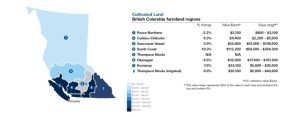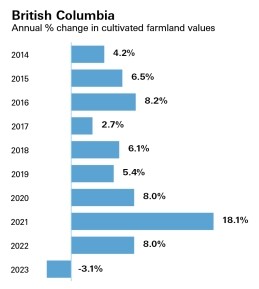
BRITISH COLUMBIA – The average value of Canadian farmland continued its steady climb in 2023, increasing by 11.5 per cent, slightly less than the 12.8 per cent increase reported in 2022, according to the latest FCC Farmland Values Report.
In British Columbia, average farmland values decreased by 3.1 per cent in 2023, following gains of 8.0 per cent in 2022 and 18.1 per cent in 2021.
 “Farmland prices have continued to increase at a rapid pace over the last couple of years, even when economic conditions suggested the growth should slow,” said J.P. Gervais, FCC’s chief economist. “A limited supply of available farmland combined with a robust demand from farm operations is driving that growth.”
“Farmland prices have continued to increase at a rapid pace over the last couple of years, even when economic conditions suggested the growth should slow,” said J.P. Gervais, FCC’s chief economist. “A limited supply of available farmland combined with a robust demand from farm operations is driving that growth.”
The highest average provincial increases in farmland values were observed in Saskatchewan, Quebec, Manitoba and Ontario, with double-digit average increases of 15.7, 13.3, 11.1 and 10.7 per cent, respectively. Four provinces had single-digit average increases and were below the national average at 7.8 per cent in Nova Scotia, 7.4 per cent in Prince Edward Island, 6.5 per cent in Alberta and 5.6 per cent in New Brunswick.
British Columbia recorded an average decline of 3.1 per cent, yet the province has the highest farmland values on average.
There were an insufficient number of publicly reported sales in Newfoundland and Labrador, Northwest Territories, Nunavut and Yukon to fully assess farmland value trends in those regions.
“The land market has shown to be very resilient,” said Gervais. “Purchasing land in the year ahead will come with careful consideration of the price and timing. Some operations will prefer to wait and see where land values will settle while others may move more quickly should adjacent land become available, or simply because it fits their strategic business plans.”
The number of farmland transactions in 2023 is estimated to have declined slightly relative to 2022 as farm operations exercised more caution towards investment decisions. “The expectation of weaker farm revenues and elevated borrowing costs and input prices are expected to stretch out this cautious environment for farmland transactions into 2024,” according to Gervais.
Gervais acknowledges that lower affordability of farmland is challenging for young producers, new entrants and those aspiring to grow their land base. This can expose some operations to more risk as they navigate higher rental rates and input costs.
Receipts of grains, oilseeds and pulses in Canada increased by 0.4 per cent in 2023 and are projected to decline by 13.2 per cent in 2024. “An important part of preparing for inevitable yet unpredictable economic changes is not only creating a risk management plan, but also updating it as those shifts in the economy unfold,” said Gervais. “Staying informed on the external factors like commodity prices and interest rates can help producers build in the necessary flexibility in their budgets.”
“The good news is that farmland value increases reflect a positive outlook for the demand of agriculture commodities and the quality food we produce in Canada,” Gervais said. “Producers have a long track record of making strategic investments in land. These long-term investments in food production have spurred growth and create a bright future for Canada’s agriculture and food industry.”
Source: fcc.ca/Economics

